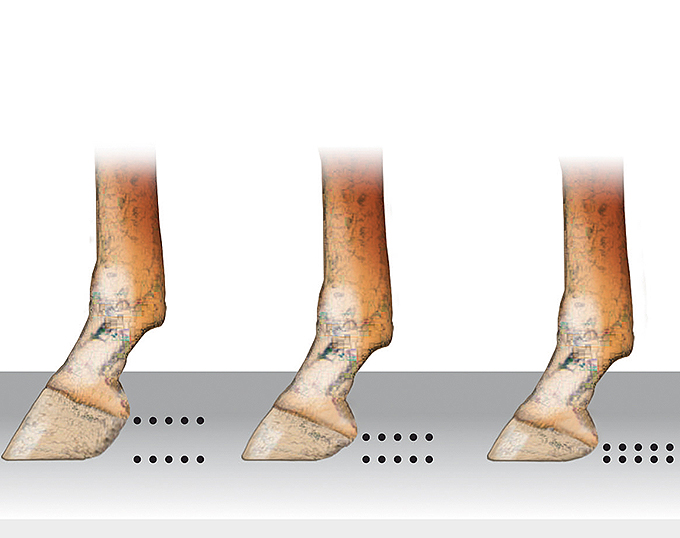
The KWPN breeding society pays close attention to correct conformation, which allows the horse to perform its work easily and, as a result, enjoy a long sport career. Correct leg conformation is an important part of this concept.
Together with Dr. Harold Brommer of the University Clinic for Horses in Utrecht and inspectors Floor Dröge and Henk Dirksen, we once again shine a light on this subject.
Hoof Angle, Heel Height
The jury views the hoof angle and the height of the heels from the side.
Brommer: “If you draw a line parallel to the hoof wall through the short- and long pastern bone, it should be one straight line. If that’s not the case, it’s undesirable. Horses with a broken-back foot axis often have flat heels. As a result, extra pressure is put on the collateral sesamoideum ligament area, the navicular bone and the deep digital flexor tendon. Extra pressure is also put on the back half of the hoof. This all can lead to accelerated wear and tear, and irritation with lameness as a result.”
Dirksen believes this issue clearly should be addressed in jumper breeding: “Certain bloodlines produce horses with very flat heels. Breeders shouldn’t underestimate this and take this into account when choosing stallions.” You also see horses with very steep feet and a broken-forward hoof axis. Brommer: “These horses, in contrast, develop more pressure in the front half of the foot, especially in the coffin joint in which, as a result, you sometimes see structural changes that can lead to osteoarthritis in the long term.”
Dissimilar Front Feet
Some horses have only one steep foot, possibly due to a past club foot that has been corrected. Dissimilar front feet are very common in horses. Fortunately, if a horse is born with dissimilar feet, the disparity is usually not an issue, or a minor one at most.

Dröge agrees: “Obviously, dissimilar front feet are a disadvantage for a horse. These horses always move out of balance, like having a sneaker on one foot and a heel on the other and then having to run a marathon like that. This regularly causes problems that eventually manifest as wear and tear, and lameness.”
Brommer: “What you also have to watch out for, is a horse that never was dissimilar but slowly begins to develop a steep foot. Then it’s important to see if there’s something wrong, in that foot or elsewhere in the skeleton.”
The KWPN Horse - selection for performance
The KWPN pays close attention to correct conformation, which allows the horse to perform its work easily and, as a result, enjoy a long sport career. Correct leg conformation is an important part of this concept. Do you want to know more about a correct conformation? Then order the book 'the KWPN Horse; selection for performance' here. KWPN members order the book for € 19.95 and non-members for € 24.50.
Related Links
Keeping Horses Barefoot: a Healthy Horse From the Ground Up
Shoeing the Dressage Horse by Rob Renirie
Classical Training: Controlling What We Can, Accommodating What We Can't